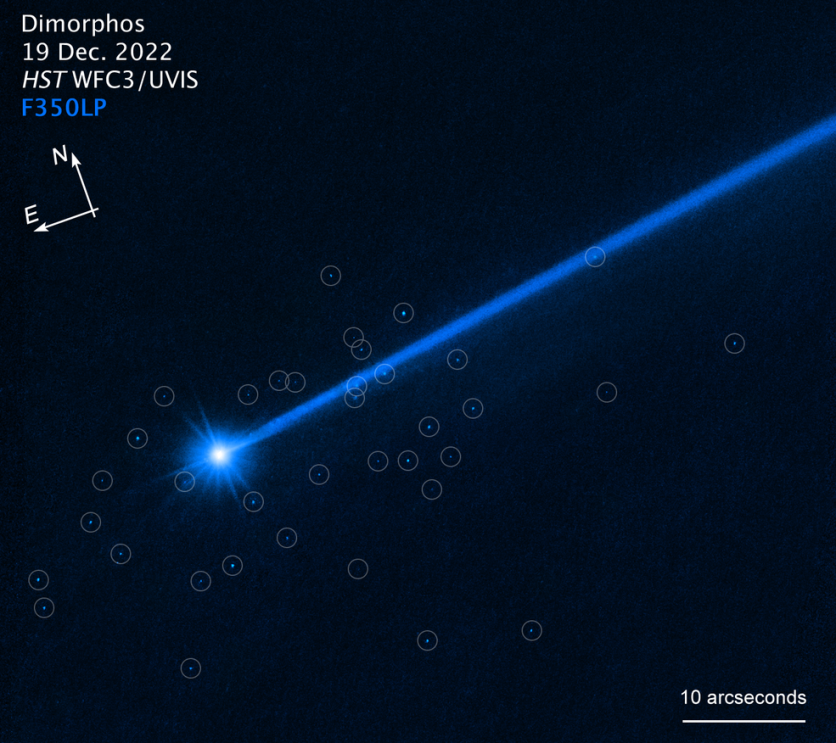NASA's Hubble Space Telescope has captured an intriguing sight of the asteroid Dimorphos in the aftermath of the Double Asteroid Redirection Test (DART) experiment.
After NASA's DART impactor spacecraft intentionally slammed Dimorphos in September 2022, astronomers using Hubble's extraordinary sensitivity observed a slight change in its orbit trajectory around the bigger asteroid Didymos.
Astronomers have also found a swarm of boulders drifting away from Dimorphos. These boulders, ranging from three to 22 feet across, were possibly shaken off the asteroid due to the impact.

NASA Hubble Space Telescope Sees Swarm of Boulders Moving at a Leisurely Pace
The 37 free-flung boulders are reportedly moving away from the asteroid at little more than a half-mile per hour, nearly similar to a giant tortoise's walking speed.
Astronomers said the total mass in these boulders is about 0.1% the mass of Dimorphos. David Jewitt of the University of California at Los Angeles, who has been monitoring the asteroid using Hubble, expressed surprise and excitement at the discovery.
He noted that this observation provides valuable insights into the aftermath of asteroid impacts and opens up new possibilities for studying the effects of such events.
"This is a spectacular observation - much better than I expected. We see a cloud of boulders carrying mass and energy away from the impact target. The numbers, sizes, and shapes of the boulders are consistent with them having been knocked off the surface of Dimorphos by the impact," Jewitt said in a statement.
"This tells us for the first time what happens when you hit an asteroid and see material coming out up to the largest sizes. The boulders are some of the faintest things ever imaged inside our solar system," he added.
The Hubble observations are also expected to aid the European Space Agency's upcoming Hera spacecraft, which is expected to arrive at the binary asteroid in late 2026.
Hera will perform a detailed post-impact survey of the targeted asteroid. According to Jewitt, the boulder cloud will still be dispersing at that time.
"It's like a very slowly expanding swarm of bees that eventually will spread along the binary pair's orbit around the Sun," he noted.
Read Also : NASA Hubble Discovers Saturn's Ring System Heats Planet's Atmosphere-A Never-Before-Seen Phenomenon!
Shaken by Seismic Waves
The boulders are believed to have been scattered across Dimorphos' surface before the impact and were not shattered pieces caused by the collision.
Instead, they were already present on the asteroid and may have been shaken loose by seismic waves or ejected as part of an ejecta plume. According to Jewitt's estimates, approximately two percent of the boulders on the asteroid's surface were dislodged by the impact.
The observations also offer an estimation of the DART impact crater's size, roughly around 160 feet in diameter. However, the precise crater size will be determined by the Hera spacecraft.
Dimorphos is thought to have originated from material discarded by Didymos. Its structure resembles a flying rubble pile loosely held together by weak gravitational forces.
While the method by which the boulders were lifted from the surface remains uncertain, future Hubble observations may shed more light on this intriguing phenomenon.
The DART and the Light Italian CubeSat for Imaging of Asteroids (LICIACube) teams have also been studying boulders detected in images taken by LICIACube's LICIACube Unit Key Explorer (LUKE) camera shortly after the DART impact. These observations offer a fascinating glimpse into the dynamic world of asteroid impacts and their aftermath.
Related Article : NASA Hubble Telescope Captures Space Cluster Containing Stars Millions of Years Old; Here's Why NGC 2660 Is Intriguing

ⓒ 2025 TECHTIMES.com All rights reserved. Do not reproduce without permission.




